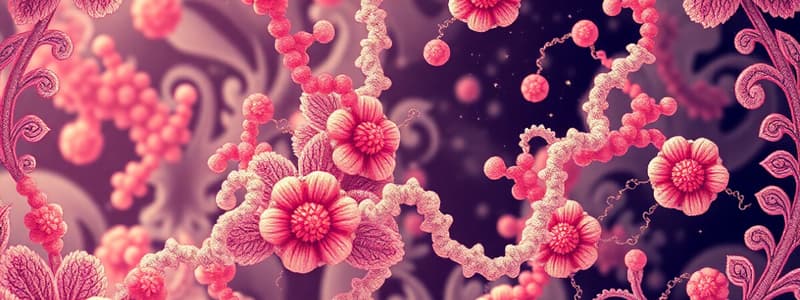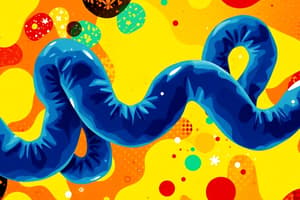Podcast
Questions and Answers
What is the primary structural polysaccharide found in plants?
What is the primary structural polysaccharide found in plants?
- Starch
- Cellulose (correct)
- Chitin
- Glycogen
Which type of bond joins two sugars together?
Which type of bond joins two sugars together?
- Peptide bond
- Glycosidic bond (correct)
- Hydrogen bond
- Ionic bond
What products are produced when amylases break down starch?
What products are produced when amylases break down starch?
- Maltose and glucose (correct)
- Cellulose and glucose
- Fructose and glucose
- Sucrose and fructose
How many standard amino acids are known to exist?
How many standard amino acids are known to exist?
What type of bond connects amino acids to form proteins?
What type of bond connects amino acids to form proteins?
Which group of amino acids is characterized by hydrophobic side chains?
Which group of amino acids is characterized by hydrophobic side chains?
What are the three groups attached to the central carbon of an amino acid?
What are the three groups attached to the central carbon of an amino acid?
How is protein structure related to its function?
How is protein structure related to its function?
What is the primary purpose of hydrolysis reactions in biological processes?
What is the primary purpose of hydrolysis reactions in biological processes?
Which type of reaction is involved in the formation of polymers from monomers?
Which type of reaction is involved in the formation of polymers from monomers?
What are the monomers of carbohydrates called?
What are the monomers of carbohydrates called?
Which of the following is a characteristic of amylopectin?
Which of the following is a characteristic of amylopectin?
Which polysaccharide serves as the main energy storage form in animals?
Which polysaccharide serves as the main energy storage form in animals?
What defines a polymer in the context of carbohydrates?
What defines a polymer in the context of carbohydrates?
Which of the following statements correctly describes monosaccharides?
Which of the following statements correctly describes monosaccharides?
What are the two main functions of polysaccharides?
What are the two main functions of polysaccharides?
What is the characteristic feature of all lipids?
What is the characteristic feature of all lipids?
Which base pairs with adenine in DNA?
Which base pairs with adenine in DNA?
What structural component distinguishes saturated fats from unsaturated fats?
What structural component distinguishes saturated fats from unsaturated fats?
What are the two smaller molecules that make up a triglyceride?
What are the two smaller molecules that make up a triglyceride?
What is the main function of phospholipids in cellular structure?
What is the main function of phospholipids in cellular structure?
Which organelle is involved in protein synthesis and processing?
Which organelle is involved in protein synthesis and processing?
Which statement is true about the structure of steroids?
Which statement is true about the structure of steroids?
What is the main role of cholesterol in cell membranes?
What is the main role of cholesterol in cell membranes?
Which type of molecules can easily pass through the plasma membrane?
Which type of molecules can easily pass through the plasma membrane?
Which of the following molecules cannot freely pass through the plasma membrane?
Which of the following molecules cannot freely pass through the plasma membrane?
What type of protein helps large polar molecules to cross the plasma membrane?
What type of protein helps large polar molecules to cross the plasma membrane?
How does facilitated diffusion differ from simple diffusion?
How does facilitated diffusion differ from simple diffusion?
What direction does water move during osmosis?
What direction does water move during osmosis?
Which term describes a solution with the same solute concentration as the cell's interior?
Which term describes a solution with the same solute concentration as the cell's interior?
What happens to a cell in a hypertonic solution?
What happens to a cell in a hypertonic solution?
What is the primary characteristic of channel proteins?
What is the primary characteristic of channel proteins?
What is denaturation in the context of proteins?
What is denaturation in the context of proteins?
Which bonds are involved in maintaining the tertiary structure of a protein?
Which bonds are involved in maintaining the tertiary structure of a protein?
What is the name of the covalent bond that holds nucleotides together?
What is the name of the covalent bond that holds nucleotides together?
What structure characterizes the primary structure of a protein?
What structure characterizes the primary structure of a protein?
What are the two types of nucleic acids and their primary functions?
What are the two types of nucleic acids and their primary functions?
What ends characterize a strand of nucleotides?
What ends characterize a strand of nucleotides?
What factor can NOT cause a protein to denature?
What factor can NOT cause a protein to denature?
What is a key difference between the nucleotides of DNA and RNA?
What is a key difference between the nucleotides of DNA and RNA?
Flashcards are hidden until you start studying
Study Notes
Hydrolysis Reactions
- Break down complex molecules into simpler ones.
- Involve adding a water molecule to split a bond.
- Purpose: Decompose polymers into monomers, making them available for biological processes.
Condensation or Dehydration Reactions
- Join two molecules together.
- Involve releasing a water molecule.
- Purpose: Synthesize larger molecules (polymers) from smaller ones (monomers).
- Key in forming macromolecules like proteins, nucleic acids, and carbohydrates.
Polymer and Monomer
- Polymer: A large molecule made up of repeating subunits.
- Monomer: A small, single molecule that can join with others to form a polymer.
- Relationship: Monomers are the building blocks of polymers.
Building and Breaking Polymers
- Condensation reactions: Add monomers to lengthen polymers.
- Hydrolysis reactions: Remove monomers to shorten polymers.
Carbohydrates
- Monomers: Monosaccharides (simple sugars, e.g., glucose).
- Polymers: Polysaccharides (complex carbohydrates).
- Monosaccharide Function: Primary energy source for living organisms.
Polysaccharide Types
- Storage: Store energy (e.g., starch in plants, glycogen in animals).
- Structural: Provide support (e.g., cellulose in plants).
Storage Polysaccharides
- Plants: Starch (amylose and amylopectin).
- Animals: Glycogen.
Starch Components
- Amylose: Linear polymer of glucose (unbranched).
- Amylopectin: Branched polymer of glucose.
Structural Polysaccharide
- Plants: Cellulose.
Sugar Isomers
- Sugars with the same molecular formula but different structural arrangements.
- Example: Glucose and fructose (both C6H12O6).
Glycosidic Bond
- The covalent bond that links two sugars together.
Amylases and Maltases
- Amylases: Break down starch into smaller sugars (e.g., maltose).
- Maltases: Break down maltose into glucose.
- Breakdown Products: Simpler sugars (maltose, glucose).
- Production: Amylases in saliva and pancreas; maltase in the small intestine.
Proteins
- Monomers: Amino acids.
- Polymers: Polypeptides or proteins.
- Peptide Bond: Covalent bond linking amino acids.
Amino Acid Structure
- Central carbon atom with three attached groups: amino group, carboxyl group, and side chain.
- Difference: Variation in the side chains determines amino acid properties.
- Number: 20 standard amino acids.
Amino Acid Groups
- Based on side chain chemistry.
- Ability to determine group membership given an amino acid structure.
Protein Structure and Function
- Closely linked.
- Structure: Specific arrangement of amino acids determines protein shape.
- Function: Protein's shape dictates how it interacts with other molecules.
Levels of Protein Structure
- Primary: Sequence of amino acids (peptide bonds).
- Secondary: Folding/coiling into structures like alpha helices or beta sheets (hydrogen bonds).
- Tertiary: Overall 3D shape of a single polypeptide chain (hydrogen bonds, ionic bonds, disulfide bridges, hydrophobic interactions).
- Quaternary: Arrangement of multiple polypeptide chains (subunits) into a single functional protein (same bonds as tertiary).
Denaturation
- Process where a protein loses its native structure.
- Impact: Loss of biological function.
- Causes: Changes in temperature, pH, exposure to chemicals.
Nucleic Acids
- DNA: Stores genetic information.
- RNA: Involved in protein synthesis and gene regulation.
Nucleic Acid Structure
- Monomers: Nucleotides.
- Polymers: Nucleic acids.
- Phosphodiester Bond: Covalent bond linking nucleotides.
Polynucleotide Structure
- Ends: 5' end (phosphate group) and 3' end (hydroxyl group).
- Bond: Hydrogen bonds hold two strands of DNA together.
Nucleotide Components
- Phosphate group, sugar, nitrogenous base.
- Difference: Variation in the nitrogenous base.
DNA Bases
- Adenine (A), guanine (G), cytosine (C), thymine (T).
RNA Bases
- Adenine (A), guanine (G), cytosine (C), uracil (U).
DNA Structure
- Double helix with two strands of nucleotides running in opposite directions.
- Base Pairing: Adenine pairs with thymine (A-T); cytosine pairs with guanine (C-G).
RNA vs DNA
- Similarities: Both are made of nucleotides and can form structures.
- Differences: RNA is typically single-stranded, has ribose sugar, and contains uracil instead of thymine.
Lipids
- Characteristic: Hydrophobic or amphipathic (do not mix well with water).
Fats
- Composed of glycerol and fatty acids.
- Official Name: Triglycerides.
- Saturated: No double bonds between carbon atoms (solid at room temperature).
- Unsaturated: One or more double bonds (liquid at room temperature).
Phospholipids
- Hydrophilic "head" (phosphate group) and two hydrophobic "tails" (fatty acids).
- Function: Form the bilayer of cell membranes, allowing for compartmentalization.
Fat vs Phospholipid
- Fat: One glycerol and three fatty acids.
- Phospholipid: One glycerol, two fatty acids, and a phosphate group.
Steroids
- Lipids with characteristic four-ring structure.
- Function: Cholesterol: Maintains membrane fluidity in cell membranes.
Cell Organelles
- Nucleus: Contains genetic material; surrounded by a nuclear envelope with pores.
- Ribosomes: Sites of protein synthesis (RNA and proteins).
- Endoplasmic Reticulum (ER):
- Rough ER: Studded with ribosomes; involved in protein synthesis and processing.
- Smooth ER: Synthesizes lipids and detoxi es harmful substances.
Membrane Transport (Diffusion & Osmosis)
Plasma Membrane Permeability
- Easy Passage: Small nonpolar molecules (oxygen, carbon dioxide), lipid-soluble substances.
- Difficult Passage: Large polar molecules (glucose), ions (Na+, K+).
- Transport Proteins: Required for molecules unable to freely pass.
Transport Protein Types
- Channel Proteins: Form pores for specific ions or water to pass through.
- Carrier Proteins: Bind to specific molecules and change shape to transport them.
Diffusion
- Movement of solutes from high concentration to low concentration until evenly spread.
- Energy Requirement: Diffusion is passive; no energy input required.
- Simple Diffusion: Diffusion across a biological membrane without assistance.
Osmosis
- Diffusion of water across a semipermeable membrane.
- Water Movement: Towards the area of higher solute concentration.
Tonicity
- Comparison of solute concentration between a solution and a cell:
- Isotonic: Equal solute concentration; no net water movement.
- Hypertonic: Higher solute concentration outside the cell; water moves out of the cell (cell shrinks).
- Hypotonic: Lower solute concentration outside the cell; water moves into the cell (cell swells and may burst).
Facilitated Diffusion
- Movement of molecules across a membrane with the help of transport proteins.
- Passive Process: Does not require energy.
- Specificity: Transport proteins bind to specific molecules.
Studying That Suits You
Use AI to generate personalized quizzes and flashcards to suit your learning preferences.




